lock BUICK RAINIER 2007 Owner's Manual
[x] Cancel search | Manufacturer: BUICK, Model Year: 2007, Model line: RAINIER, Model: BUICK RAINIER 2007Pages: 534, PDF Size: 2.87 MB
Page 1 of 534
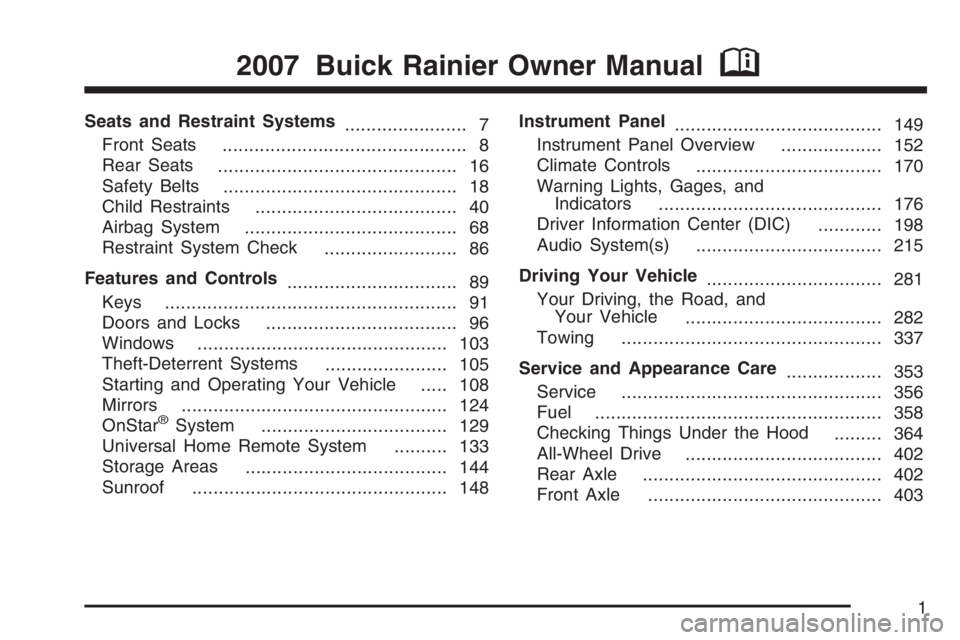
Seats and Restraint Systems
....................... 7
Front Seats
.............................................. 8
Rear Seats
............................................. 16
Safety Belts
............................................ 18
Child Restraints
...................................... 40
Airbag System
........................................ 68
Restraint System Check
......................... 86
Features and Controls
................................ 89
Keys
....................................................... 91
Doors and Locks
.................................... 96
Windows
............................................... 103
Theft-Deterrent Systems
....................... 105
Starting and Operating Your Vehicle
..... 108
Mirrors
.................................................. 124
OnStar
®System
................................... 129
Universal Home Remote System
.......... 133
Storage Areas
...................................... 144
Sunroof
................................................ 148Instrument Panel
....................................... 149
Instrument Panel Overview
................... 152
Climate Controls
................................... 170
Warning Lights, Gages, and
Indicators
.......................................... 176
Driver Information Center (DIC)
............ 198
Audio System(s)
................................... 215
Driving Your Vehicle
................................. 281
Your Driving, the Road, and
Your Vehicle
..................................... 282
Towing
................................................. 337
Service and Appearance Care
.................. 353
Service
................................................. 356
Fuel
...................................................... 358
Checking Things Under the Hood
......... 364
All-Wheel Drive
..................................... 402
Rear Axle
............................................. 402
Front Axle
............................................ 403
2007 Buick Rainier Owner ManualM
1
Page 11 of 534
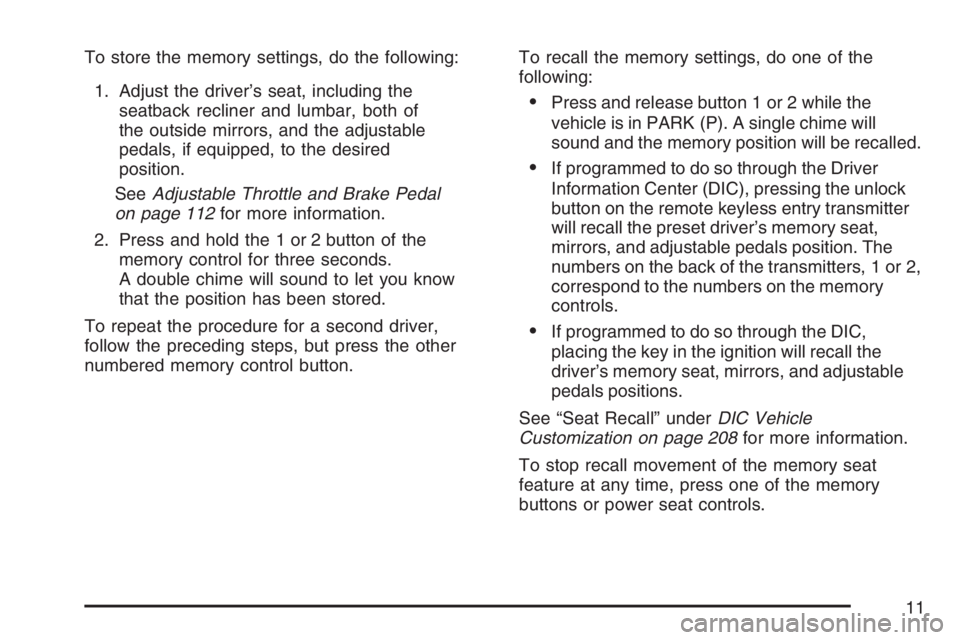
To store the memory settings, do the following:
1. Adjust the driver’s seat, including the
seatback recliner and lumbar, both of
the outside mirrors, and the adjustable
pedals, if equipped, to the desired
position.
SeeAdjustable Throttle and Brake Pedal
on page 112for more information.
2. Press and hold the 1 or 2 button of the
memory control for three seconds.
A double chime will sound to let you know
that the position has been stored.
To repeat the procedure for a second driver,
follow the preceding steps, but press the other
numbered memory control button.To recall the memory settings, do one of the
following:
Press and release button 1 or 2 while the
vehicle is in PARK (P). A single chime will
sound and the memory position will be recalled.
If programmed to do so through the Driver
Information Center (DIC), pressing the unlock
button on the remote keyless entry transmitter
will recall the preset driver’s memory seat,
mirrors, and adjustable pedals position. The
numbers on the back of the transmitters, 1 or 2,
correspond to the numbers on the memory
controls.
If programmed to do so through the DIC,
placing the key in the ignition will recall the
driver’s memory seat, mirrors, and adjustable
pedals positions.
See “Seat Recall” underDIC Vehicle
Customization on page 208for more information.
To stop recall movement of the memory seat
feature at any time, press one of the memory
buttons or power seat controls.
11
Page 17 of 534
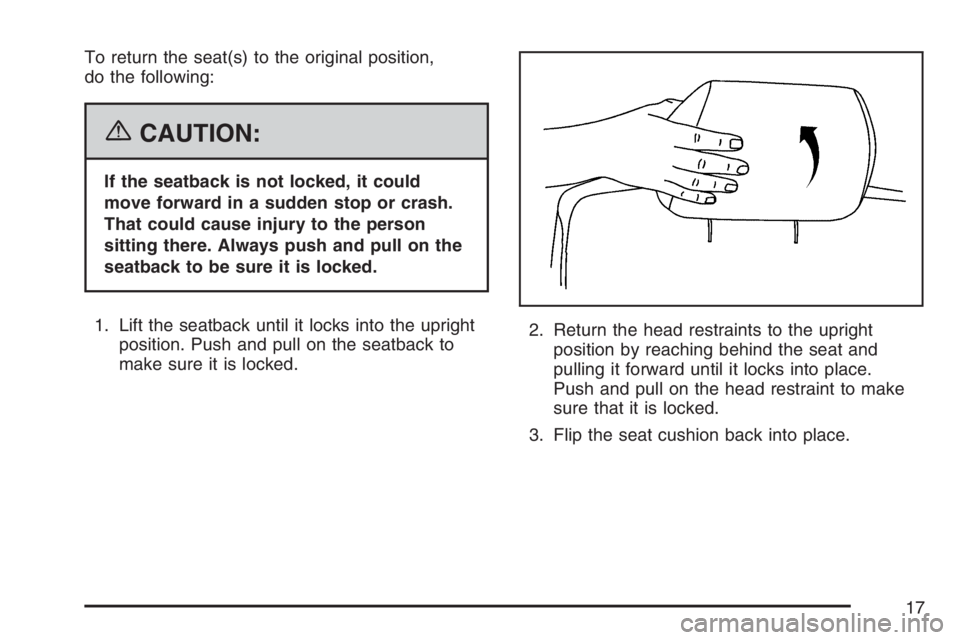
To return the seat(s) to the original position,
do the following:
{CAUTION:
If the seatback is not locked, it could
move forward in a sudden stop or crash.
That could cause injury to the person
sitting there. Always push and pull on the
seatback to be sure it is locked.
1. Lift the seatback until it locks into the upright
position. Push and pull on the seatback to
make sure it is locked.2. Return the head restraints to the upright
position by reaching behind the seat and
pulling it forward until it locks into place.
Push and pull on the head restraint to make
sure that it is locked.
3. Flip the seat cushion back into place.
17
Page 24 of 534
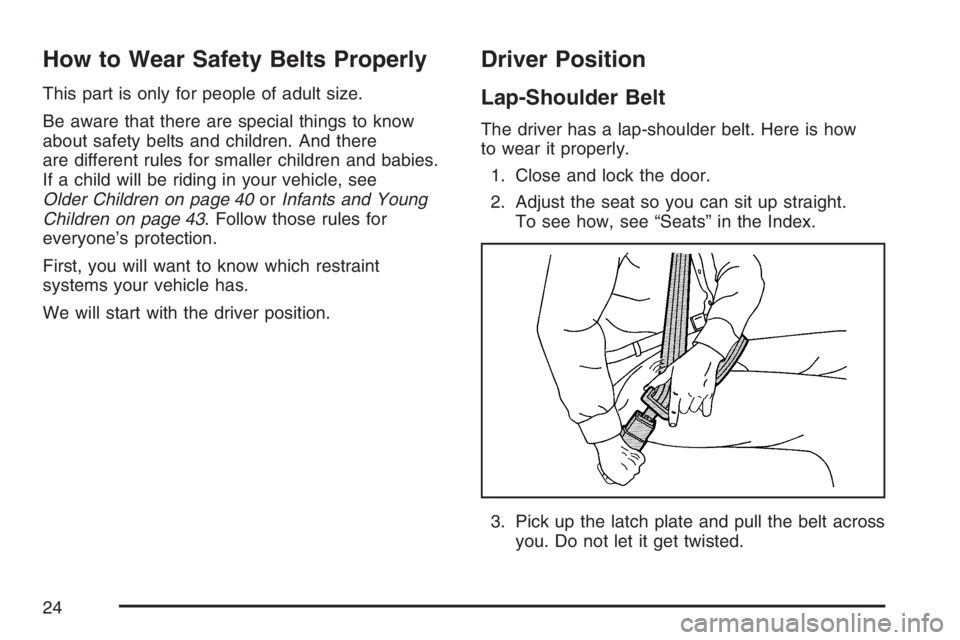
How to Wear Safety Belts Properly
This part is only for people of adult size.
Be aware that there are special things to know
about safety belts and children. And there
are different rules for smaller children and babies.
If a child will be riding in your vehicle, see
Older Children on page 40orInfants and Young
Children on page 43. Follow those rules for
everyone’s protection.
First, you will want to know which restraint
systems your vehicle has.
We will start with the driver position.
Driver Position
Lap-Shoulder Belt
The driver has a lap-shoulder belt. Here is how
to wear it properly.
1. Close and lock the door.
2. Adjust the seat so you can sit up straight.
To see how, see “Seats” in the Index.
3. Pick up the latch plate and pull the belt across
you. Do not let it get twisted.
24
Page 25 of 534
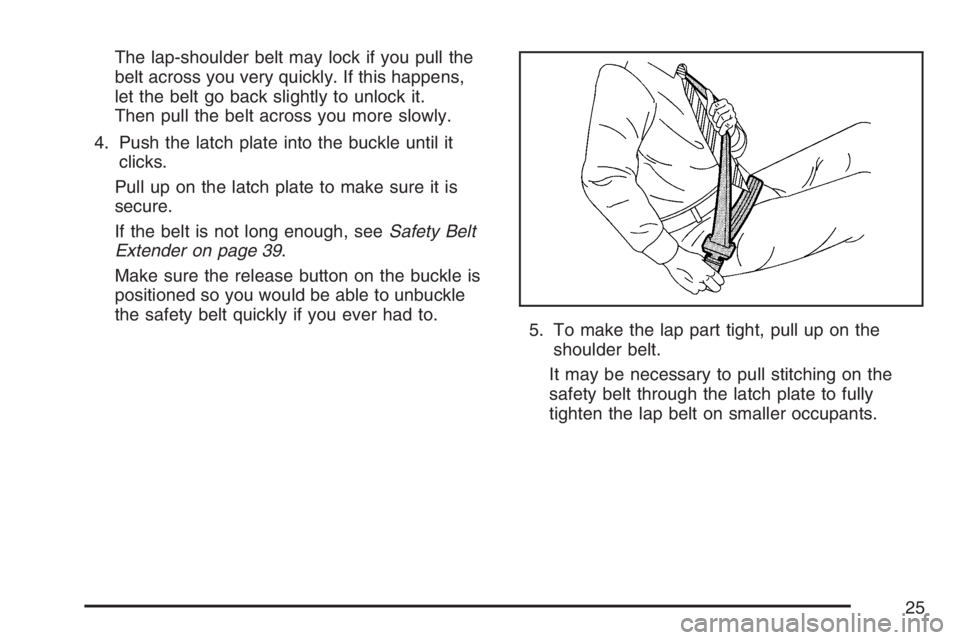
The lap-shoulder belt may lock if you pull the
belt across you very quickly. If this happens,
let the belt go back slightly to unlock it.
Then pull the belt across you more slowly.
4. Push the latch plate into the buckle until it
clicks.
Pull up on the latch plate to make sure it is
secure.
If the belt is not long enough, seeSafety Belt
Extender on page 39.
Make sure the release button on the buckle is
positioned so you would be able to unbuckle
the safety belt quickly if you ever had to.
5. To make the lap part tight, pull up on the
shoulder belt.
It may be necessary to pull stitching on the
safety belt through the latch plate to fully
tighten the lap belt on smaller occupants.
25
Page 26 of 534
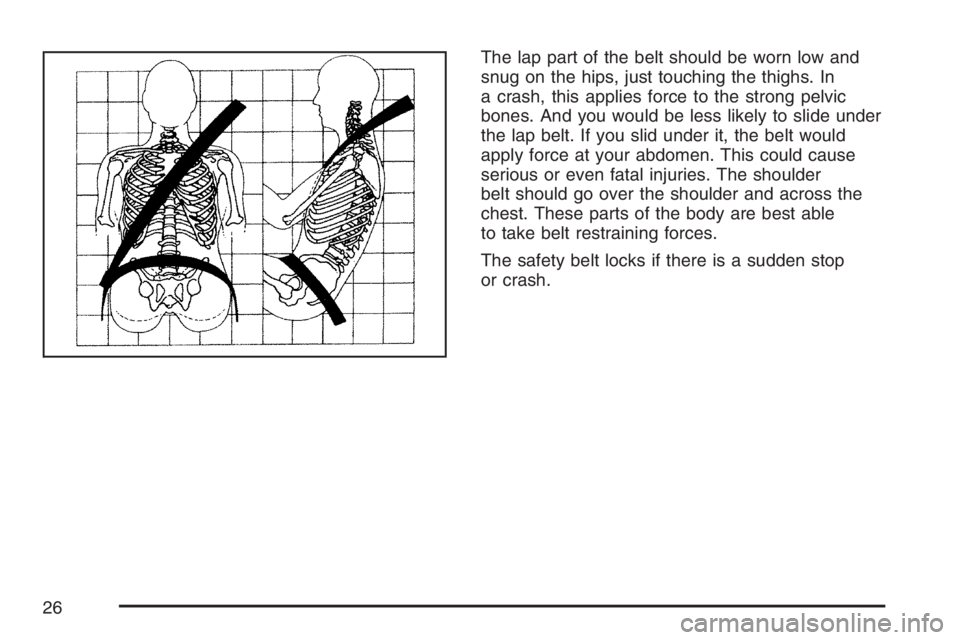
The lap part of the belt should be worn low and
snug on the hips, just touching the thighs. In
a crash, this applies force to the strong pelvic
bones. And you would be less likely to slide under
the lap belt. If you slid under it, the belt would
apply force at your abdomen. This could cause
serious or even fatal injuries. The shoulder
belt should go over the shoulder and across the
chest. These parts of the body are best able
to take belt restraining forces.
The safety belt locks if there is a sudden stop
or crash.
26
Page 33 of 534
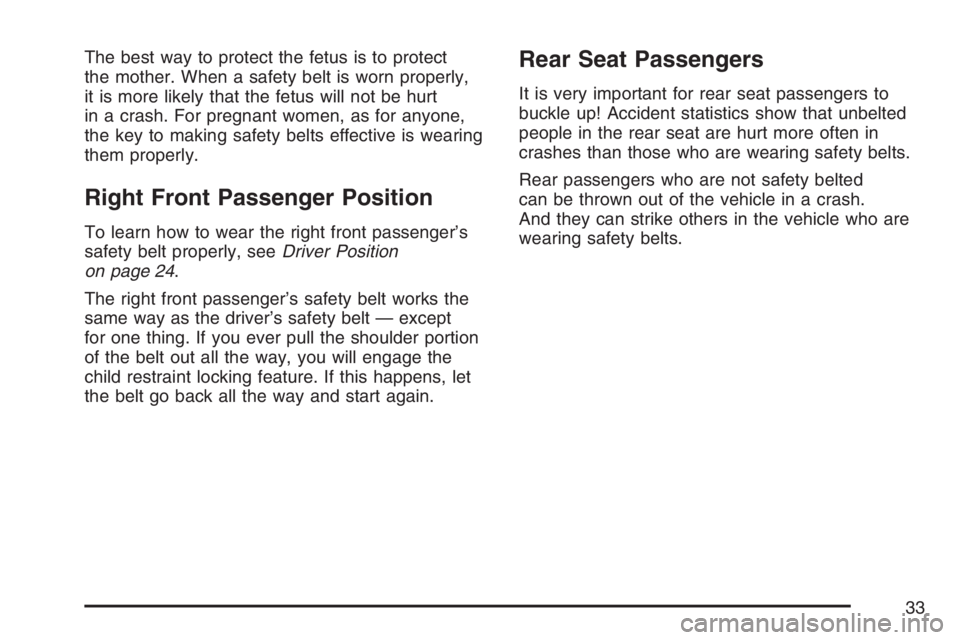
The best way to protect the fetus is to protect
the mother. When a safety belt is worn properly,
it is more likely that the fetus will not be hurt
in a crash. For pregnant women, as for anyone,
the key to making safety belts effective is wearing
them properly.
Right Front Passenger Position
To learn how to wear the right front passenger’s
safety belt properly, seeDriver Position
on page 24.
The right front passenger’s safety belt works the
same way as the driver’s safety belt — except
for one thing. If you ever pull the shoulder portion
of the belt out all the way, you will engage the
child restraint locking feature. If this happens, let
the belt go back all the way and start again.
Rear Seat Passengers
It is very important for rear seat passengers to
buckle up! Accident statistics show that unbelted
people in the rear seat are hurt more often in
crashes than those who are wearing safety belts.
Rear passengers who are not safety belted
can be thrown out of the vehicle in a crash.
And they can strike others in the vehicle who are
wearing safety belts.
33
Page 34 of 534
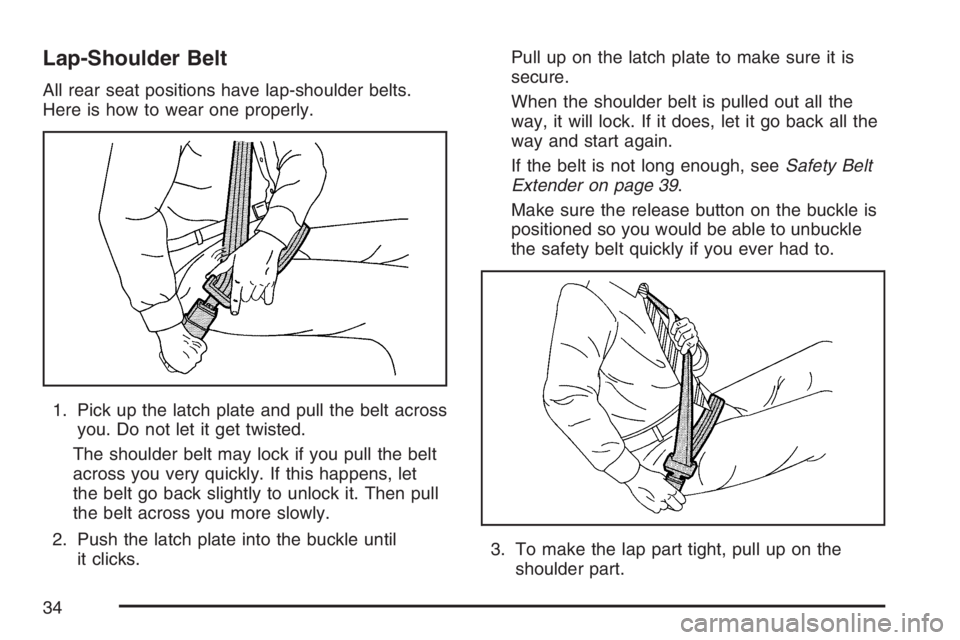
Lap-Shoulder Belt
All rear seat positions have lap-shoulder belts.
Here is how to wear one properly.
1. Pick up the latch plate and pull the belt across
you. Do not let it get twisted.
The shoulder belt may lock if you pull the belt
across you very quickly. If this happens, let
the belt go back slightly to unlock it. Then pull
the belt across you more slowly.
2. Push the latch plate into the buckle until
it clicks.Pull up on the latch plate to make sure it is
secure.
When the shoulder belt is pulled out all the
way, it will lock. If it does, let it go back all the
way and start again.
If the belt is not long enough, seeSafety Belt
Extender on page 39.
Make sure the release button on the buckle is
positioned so you would be able to unbuckle
the safety belt quickly if you ever had to.
3. To make the lap part tight, pull up on the
shoulder part.
34
Page 35 of 534
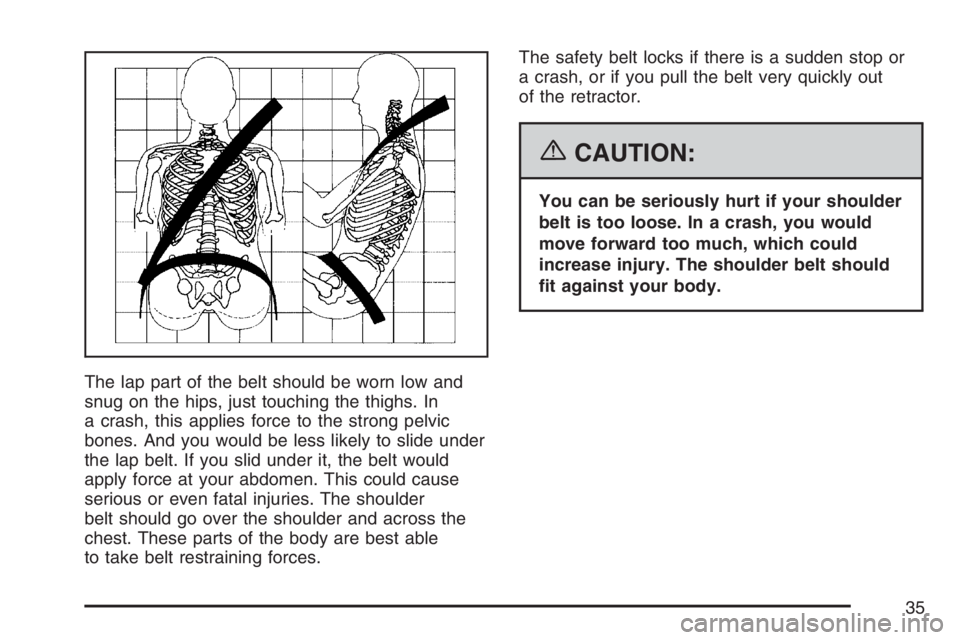
The lap part of the belt should be worn low and
snug on the hips, just touching the thighs. In
a crash, this applies force to the strong pelvic
bones. And you would be less likely to slide under
the lap belt. If you slid under it, the belt would
apply force at your abdomen. This could cause
serious or even fatal injuries. The shoulder
belt should go over the shoulder and across the
chest. These parts of the body are best able
to take belt restraining forces.The safety belt locks if there is a sudden stop or
a crash, or if you pull the belt very quickly out
of the retractor.
{CAUTION:
You can be seriously hurt if your shoulder
belt is too loose. In a crash, you would
move forward too much, which could
increase injury. The shoulder belt should
�t against your body.
35
Page 56 of 534
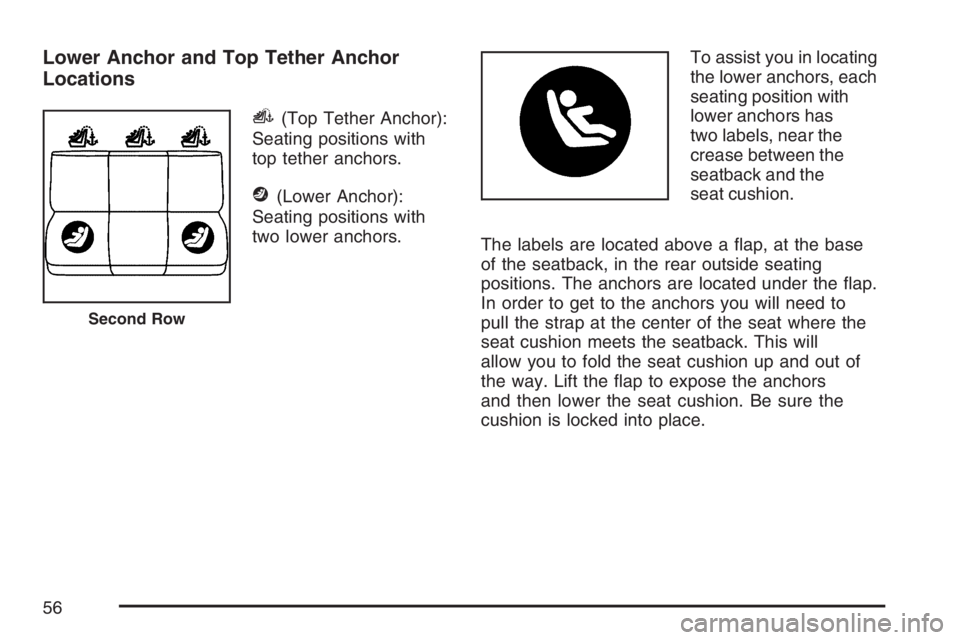
Lower Anchor and Top Tether Anchor
Locations
i(Top Tether Anchor):
Seating positions with
top tether anchors.
j(Lower Anchor):
Seating positions with
two lower anchors.To assist you in locating
the lower anchors, each
seating position with
lower anchors has
two labels, near the
crease between the
seatback and the
seat cushion.
The labels are located above a �ap, at the base
of the seatback, in the rear outside seating
positions. The anchors are located under the �ap.
In order to get to the anchors you will need to
pull the strap at the center of the seat where the
seat cushion meets the seatback. This will
allow you to fold the seat cushion up and out of
the way. Lift the �ap to expose the anchors
and then lower the seat cushion. Be sure the
cushion is locked into place.
Second Row
56